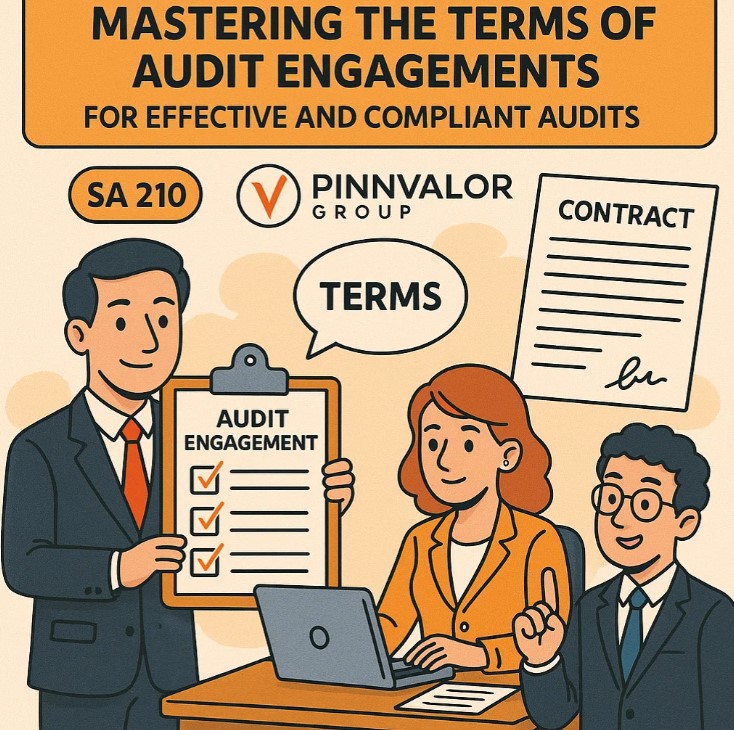
SA 210 – Mastering the Terms of Audit Engagements for Effective and Compliant Audits
Auditing is not just about verifying financial statements; it is about building trust, ensuring compliance, and establishing clear responsibilities between auditors and clients. SA 210 – Terms of Audit Engagements provides the foundation for this process, setting out the framework to define and agree on the scope, objectives, and responsibilities of both parties before the audit begins. Understanding and implementing SA 210 is crucial for auditors to ensure clarity, avoid disputes, and conduct an efficient audit.
Are your audit engagements truly clear, compliant, and dispute-proof under SA 210?
Mastering the terms of audit engagements builds trust and accountability. Auditors and management align expectations, reducing disputes and enhancing efficiency.
Introduction to SA 210
The Standards on Auditing (SA) 210 is issued to guide auditors on the terms of audit engagements. It emphasizes the importance of formalizing agreements between the auditor and the client regarding the scope, objectives, and limitations of the audit. Clear communication at the beginning of an engagement reduces the risk of misunderstandings and ensures a smooth audit process.
Objectives of SA 210
The key objectives of SA 210 are:
- Agreement on the Audit Terms: Ensure that the auditor and client have a mutual understanding of the engagement’s scope and responsibilities.
- Clarity in Roles: Define the responsibilities of both the auditor and the management.
- Minimization of Misunderstandings: Reduce the likelihood of disputes regarding the audit process or reporting.
Key Elements of the Terms of Audit Engagement
SA 210 requires the engagement terms to include certain critical elements. These include:
1. Objective and Scope of the Audit
The engagement letter must clearly outline the purpose of the audit, which is typically to provide an opinion on the financial statements in accordance with applicable accounting standards. It should also define the scope, detailing areas of examination and any limitations.
2. Responsibilities of Management
Management is responsible for:
- Preparing financial statements in accordance with the applicable financial reporting framework.
- Designing and implementing internal controls to prevent and detect fraud and errors.
- Providing access to all necessary information and documents required for the audit.
3. Responsibilities of the Auditor
The auditor’s responsibilities include:
- Conducting the audit in accordance with Standards on Auditing (SAs).
- Planning and performing audit procedures to obtain reasonable assurance that financial statements are free from material misstatement.
- Communicating significant findings, including weaknesses in internal controls, to management and those charged with governance.
4. Form and Use of the Engagement Letter
The engagement letter is the primary means of documenting the terms of the audit engagement. Key points include:
- Identification of the entity being audited.
- Objective and scope of the audit.
- Auditor and management responsibilities.
- Reporting framework to be used.
- Agreement on fees and billing arrangements.
- Reference to any other services to be provided, if applicable.
5. Modifications to the Terms
If circumstances change during the audit—such as new information coming to light or changes in the scope—the terms of the engagement should be revised and agreed upon in writing.
Importance of SA 210 in Practice
Implementing SA 210 effectively brings several benefits:
- Enhanced Professionalism: Demonstrates structured and ethical audit practices.
- Clarity and Transparency: Both parties understand expectations, reducing conflicts.
- Legal Protection: Provides a documented agreement that can help resolve disputes if disagreements arise.
- Efficient Audit Execution: Clear responsibilities and scope enable auditors to plan and execute the audit more effectively.

Common Challenges and Practical Tips
- Incomplete Engagement Letters: Ensure all key elements, including scope, responsibilities, and reporting framework, are explicitly stated.
- Ambiguous Language: Use clear and precise language to avoid misinterpretation.
- Changes During Audit: Document any modifications in writing and get mutual agreement.
- Client Resistance: Educate clients on the importance of engagement letters for a smooth and compliant audit.
Conclusion
SA 210 – Terms of Audit Engagements is not merely a formal requirement but a practical tool to ensure effective and compliant audits. By mastering the terms of engagement, auditors can foster better communication, establish clear expectations, and execute audits efficiently while adhering to professional standards. For both auditors and management, SA 210 acts as a roadmap for a transparent and successful audit journey.
